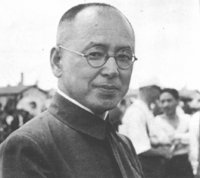Masahiko Amakasu
| Masahiko Amakasu 甘粕 正彦 | |
|---|---|
|
Masahiko Amakasu in Manchukuo | |
| Born |
January 26, 1891 Miyagi Prefecture, Japan |
| Died |
August 20, 1945 (aged 54) Hsinking, Manchukuo |
| Nationality | Japanese |
| Occupation | Military officer, head of Manchukuo Film Association |
Masahiko Amakasu (甘粕 正彦 Amakasu Masahiko, January 26, 1891 – August 20, 1945) was an officer in the Imperial Japanese Army imprisoned for his involvement in the Amakasu Incident, the extrajudicial execution of anarchists after the 1923 Great Kantō earthquake, who later became head of the Manchukuo Film Association.
Biography
Amakasu was born in Miyagi Prefecture as the eldest son of an ex-samurai of the Yonezawa Domain. He was educated in military boarding schools in Mie Prefecture and Nagoya, and entered the Imperial Japanese Army Academy in 1912. After graduation, he served in the infantry and then the military police in various postings in Japan and in Korea.
As a lieutenant in charge of a detachment of military police during the chaos immediately following the 1923 Great Kantō earthquake on September 16, 1923, his detachment arrested the well-known anarchists Sakae Ōsugi and Noe Itō, along with Sakae's six-year-old nephew. In what came to be known as the Amakasu Incident, the suspects were beaten to death and their bodies thrown into a well. The killing of such high-profile anarchists, along with a young child, sparked surprise and outrage throughout Japan. Amakasu was court martialed and sentenced to serve 10 years in Chiba Prison.[1]
However, Amakasu was released after only three years due to a general amnesty proclaimed in celebration of the ascension of Hirohito as Emperor of Japan. After his release, Amakasu was sent to France to study by the Japanese Army from July 1927. While in France, he became acquainted with the noted artist Tsuguharu Foujita. He returned to Japan in 1930, but almost immediately relocated to Mukden in Manchuria, where he worked under Japanese spymaster Kenji Doihara to manage the Japanese Army's increasing involvement in opium production and smuggling into China. After the Marco Polo Bridge Incident and the Manchurian Incident, he relocated to Harbin, where he was involved in the effort to smuggle ex-Qing emperor Puyi from the foreign concession in Tianjin into Manchuria, where he would become the puppet ruler of the new state of Manchukuo. In Manchukuo, Amakasu helped establish the civilian police force in the new capital of Hsinking.
In 1939, with the support of Nobusuke Kishi, he was named the head of Manchukuo Film Association, which was one of the main propaganda vehicles for the Kwantung Army to boost public support for Manchukuo and for the war effort against the Kuomintang government of China.[2] Amakasu strove hard to improve the quality of the works produced, traveling to Germany to acquire the latest movie cameras and production techniques, and inviting noted Japanese movie stars, directors and conductors (such as Takashi Asahina) to visit Manchukuo and to participate in his productions. His efforts were instrumental in launching the career of Yoshiko Ōtaka, better known as "Ri Kōran" in Japanese.[3]
With the fall of Manchukuo to Soviet forces during the invasion of Manchuria in August 1945, Amakasu committed suicide by taking potassium cyanide.
In Popular Culture
- Amakasu was portrayed by Japanese musician Ryuichi Sakamoto in the 1987 film The Last Emperor, although he was shown shooting himself to death in the movie.[4]
- Amakasu is also a character in the historical fantasy novel Teito Monogatari by Hiroshi Aramata. In the novel, he is involved with the freemasons.
- Amakasu was featured as a character in Ian Buruma's novel The China Lover, released in 2008.
- Amakasu was featured in the 2014 Visual Novel Soushuu Senshinkan Gakuen Hachimyoujin as the main villain.
See also
| Wikimedia Commons has media related to Masahiko Amakasu. |
Notes
References
- Jansen, Marius B. (2000). The Making of Modern Japan. Harvard University Press.ISBN 9780674003347; OCLC 44090600
- Nornes, Abé Mark (1994). Japan/America Film Wars: WWII Propaganda and Its Cultural Contexts. Harwood Academic Publishers. ISBN 3-7186-0562-7.
- Young, Louise (1999). Japan's Total Empire: Manchuria and the Culture of Wartime Imperialism. University of California Press. ISBN 0-520-21934-1.
